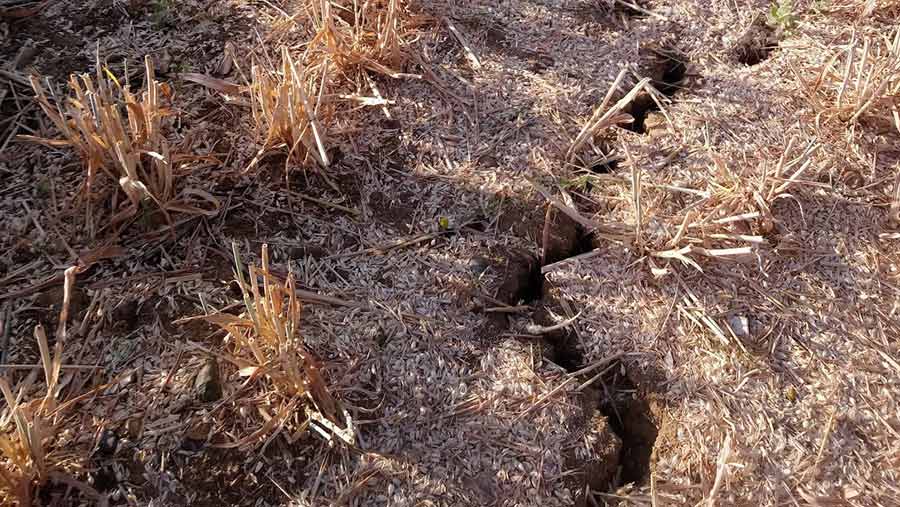Flindt on Friday: A good crack beats a soggy soil any season
 © Kathy Horniblow
© Kathy Horniblow There’s a lot of fuss and bother going on at the moment about cracks in arable fields.
My fellow farmers are poking sticks down them, lowering their phones into them, taking dramatic drone shots of them – and all with a sense of doom.
I love cracks in the ground. We’ve just got out of our heaviest land (Stanmore), and it was a veritable mass of chaff-lined crevasses.
It got me thinking of a wet harvest back in the 1980s, when the cocky youngster just out of uni thought he’d ignore the advice of Ken the combine driver – “Don’t go driving over that ridge, nipper!” – and the grain trailer sank to its axles. “That’ll learn you.”
See also: Crops struggle with lack of rain as drought fears intensify
The ceremony of fetching the only 4wd tractor and a chain was unnecessarily long and much overplayed – probably to increase the chances of Dad arriving in a fury to find out what the delay was, and give me a public earful.
Even in a normal year, traffic on that block of clay next to the woods (which were supposedly planted after generations found the land too unwieldy for anything else) will leave its mark.

One of Stanmore’s many cracks © Charlie Flindt
Appliance of science
I always think of my soil guru at Newcastle, Prof Alan Reece, who would leap round a lecture room loudly imparting his views on soil science, especially his killer phrase:
“Tractors are brilliant things – except when you drive ’em across a field!”
His trademark cackle would ensue. I miss the days when soil science was brought to you by scientists armed with equations rather than shamans armed with feelings.
This year, the new combine and both tractors are skipping across the stubble without making a mark. Reecey would approve.
And, after nearly 40 harvests, I have a collection of shudder-inducing memories of that block of land during soggy years.
Driving up there, full of enthusiasm for a pre-harvest check, only to find all the wheat had sprouted.
July storms sweeping in and flattening anything from the fertiliser overlaps to the whole flipping lot.
The police knocking on the door to tell me a Cessna had crash-landed in Long Field.
A Cessna? Well, in the previous autumn, the plough had got ahead of the power harrow and drill (separate units in those days) and a lunchtime storm rendered a long narrow strip undrillable. And so it stayed for the whole year.
Come June, a Cessna with engine trouble headed for the “strip” before realising at the last moment it was ploughed, and put down in the wheat instead.
Wet behind the wheat ears
Then there was harvest 1992 – our first in charge. The rain started in early August and was relentless.
By the time we got up to the wheat in Stanmore, it was the end of September.
The inside of the Dominator was caked with cereal paste, and the unloading arm was going through shearbolts by the bag.
“No, I won’t sell you 10.9 bolts,” said the stern brown-coated storeman at Curtis Padwick. “You’ll do more damage elsewhere. Have another bag of 8.8s instead. Now go away. Sir.”
The last sprouted load of Haven flopped out of the unloading arm on 1 October.
That’s why I’m smiling from the cab at the maze of cracks criss-crossing the clay. It means hard ground and easy harvesting.
It’s Mother Nature’s subsoiler at work. (Best not tell Mother Nature that subsoiling, according to modern soil science, is “bad”, though. She’d have a fit at that news.)
And let’s not forget that droughts drop yields and, as Putin has proved, nothing concentrates minds more on what a block of Hampshire clay is actually for than a shortage.

